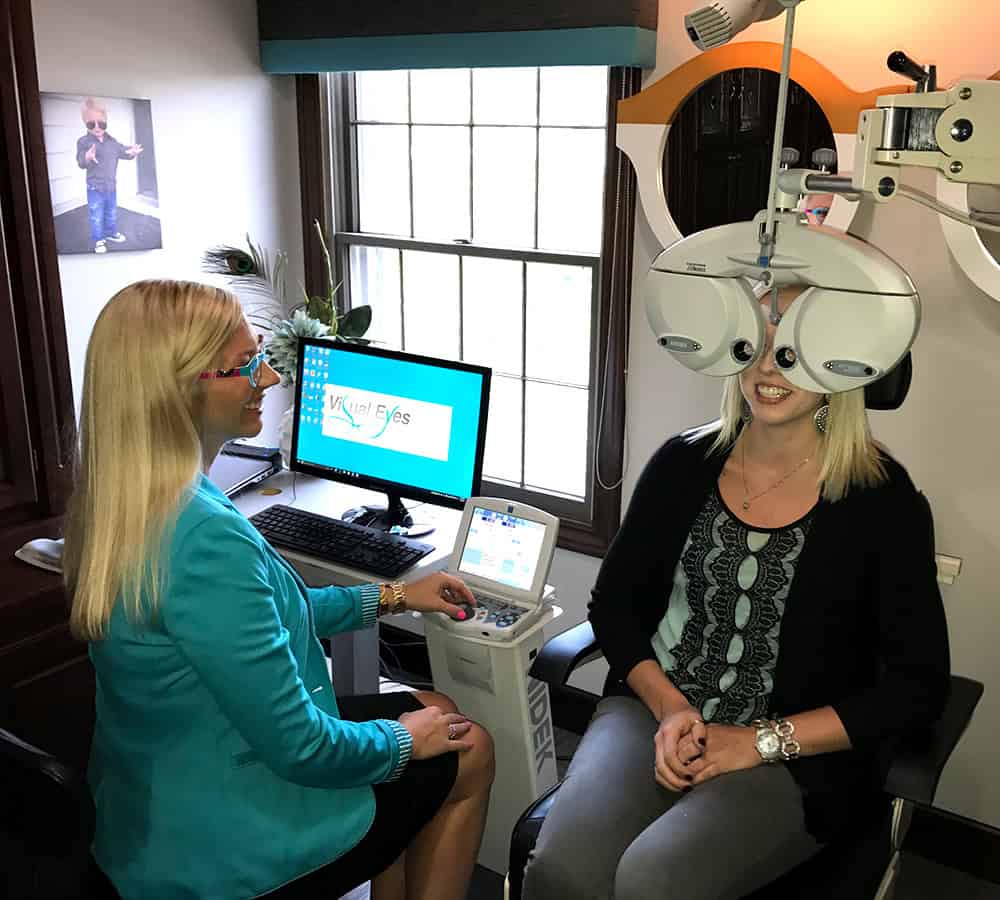Comprehensive Eye Exam
Yearly eye health and vision examinations are an important part of preventive health care
Many eye and vision problems have no obvious signs or symptoms. As a result, individuals are often unaware that problems exist. The early diagnosis and treatment of eye and vision problems are important for maintaining good vision and eye health, and when possible, preventing vision loss.
That’s why yearly eye health and vision examinations are crucial for the health of your eyes.
At Visual Eyes, we are passionate about our patient’s eyes and provide a complete and comprehensive eye exam that covers all aspects of eye health for all age ranges. Dr. Miller recommends the first eye exam happen between six to 12 months of age. The second eye exam should be at 3 years old. The third exam should be before kindergarten and then every year thereafter.

Our eye exams will cover the following checks and tests.
Patient History
A patient history helps to determine any symptoms the individual is experiencing, when they began, the presence of any general health problems, medications taken, and occupational or environmental conditions that may be affecting vision. Dr. Miller will ask about any eye or vision problems you may be having, about your overall health, and about any previous eye or health conditions you or your family members may have.
Visual Acuity
Visual acuity measurements evaluate how clearly each eye is seeing. As part of the testing, you are asked to read letters on distance and near reading charts. If the patient cannot read, we will use shapes. The results of visual acuity testing are written as a fraction such as 20/40. When testing distance vision, the top number in the fraction is the standard distance at which testing is done, twenty feet. The bottom number is the smallest letter size you were able to read. A person with 20/40 visual acuity would have to get within 20 feet of a letter that should be seen at 40 feet in order to see it clearly. Normal distance visual acuity is 20/20.
Preliminary Tests
Preliminary testing may include evaluation of specific aspects of visual function and eye health such as depth perception, color vision, eye muscle movements, peripheral or side vision, and the way your pupils respond to light. We will also evaluate the vision and fit of contact lenses.
Keratometry
This test measures the curvature of the cornea, the clear outer surface of the eye, by focusing a circle of light on the cornea and measuring its reflection. This measurement is particularly critical in determining the proper fit for contact lenses.
Refraction
Refraction is conducted to determine the appropriate lens power needed to compensate for any refractive error (nearsightedness, farsightedness, or astigmatism). Using an instrument called a phoropter, we will place a series of lenses in front of your eyes and measure how they focus light using a handheld lighted instrument called a retinoscope. It can be stressful to answer, “Which is better, one or two.” With the use of the phoropter, we can limit how many times you are asked, and achieve an accurate prescription. Depending on your eyes, Dr. Miller may choose to use an automated instrument that automatically evaluates the focusing power of the eye. The power is then refined by the patient’s responses to determine the lenses that allow the clearest vision. This testing may be done without the use of eye drops to determine how the eyes respond under normal seeing conditions. In some cases, such as for patients who can’t respond verbally or when some of the eye’s focusing power may be hidden, eye drops are used. The drops temporarily keep the eyes from changing focus while testing is done.
Eye Focusing, Eye Teaming, and Eye Movement Testing
Assessment of accommodation, ocular motility, and binocular vision determines how well the eyes focus, move and work together. In order to obtain a clear, single image of what is being viewed, the eyes must effectively change focus, move, and work in unison. This testing will look for problems that keep your eyes from focusing effectively or make using both eyes together difficult.
Eye Health Evaluation
External examination of the eye includes evaluation of the cornea, eyelids, conjunctiva, and surrounding eye tissue using bright light and magnification. Evaluation of the lens, retina, and posterior section of the eye may be done through a dilated pupil to provide a better view of the internal structures of the eye. Measurement of pressure within the eye (tonometry) is performed. Normal eye pressures range from 10 to 21 millimeters of mercury (mm Hg), averaging about 14 to 16 mm Hg. Anyone with eye pressure greater than 22 mm Hg is at an increased risk of developing glaucoma, although many people with normal pressure also develop glaucoma.
Supplemental Testing
Additional testing may be needed based on the results of the previous tests to confirm or rule out possible problems, clarify uncertain findings, or provide a more in-depth assessment. At the completion of the examination, we will assess and evaluate the results of the testing to determine a diagnosis and develop a treatment plan. He or she will discuss with you the nature of any visual or eye health problems found and explain available treatment options. In some cases, referral for consultation with, or treatment by an ophthalmologist or other health care provider may be indicated. If you have questions regarding any eye or vision conditions diagnosed or treatment recommended, don’t hesitate to ask for additional information or explanation from your doctor.
